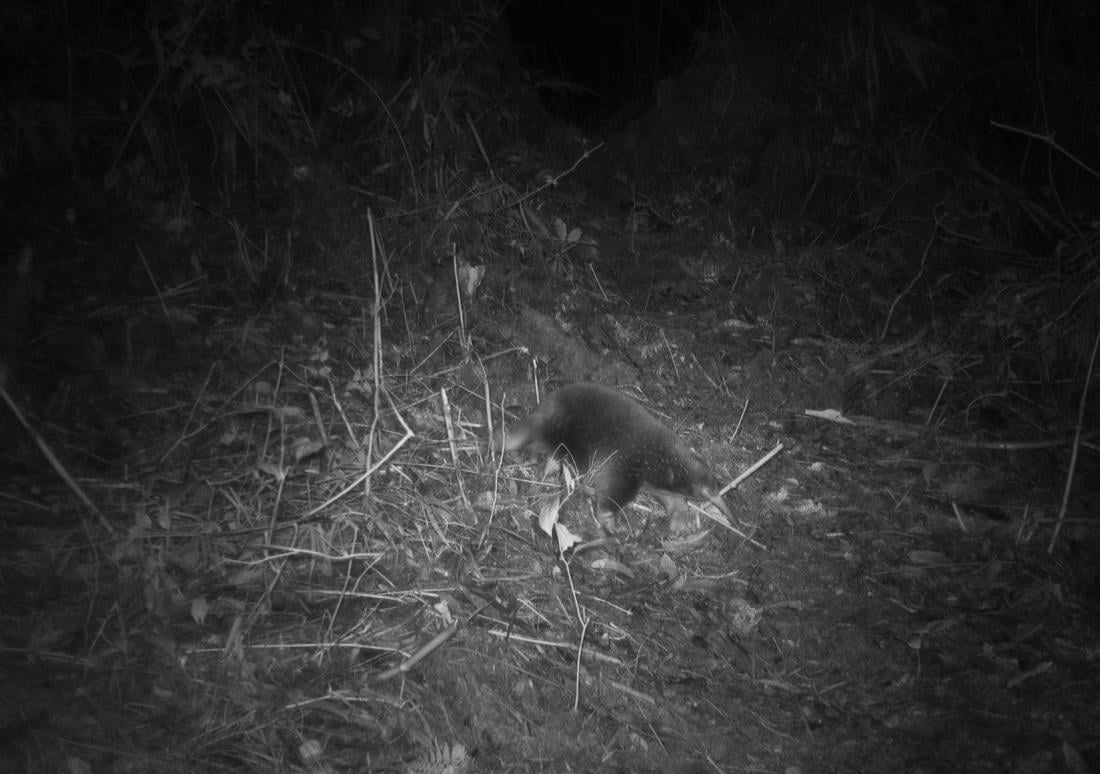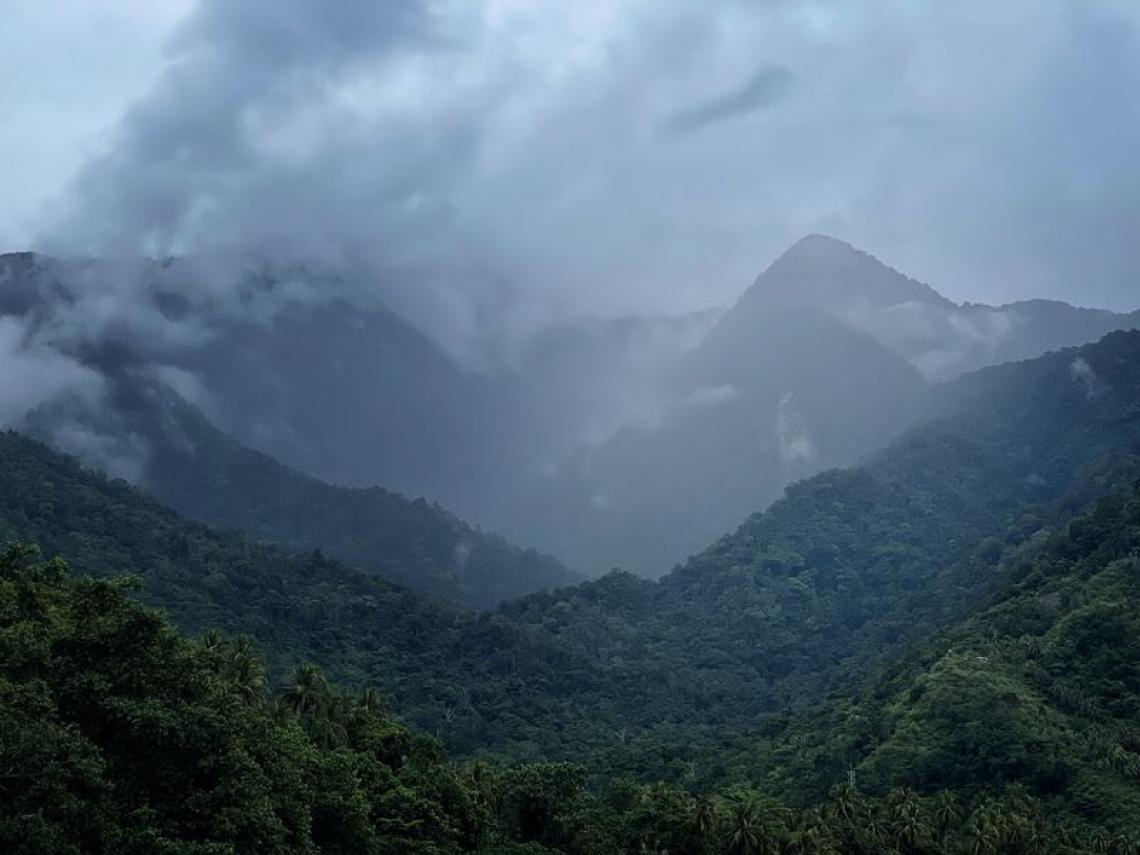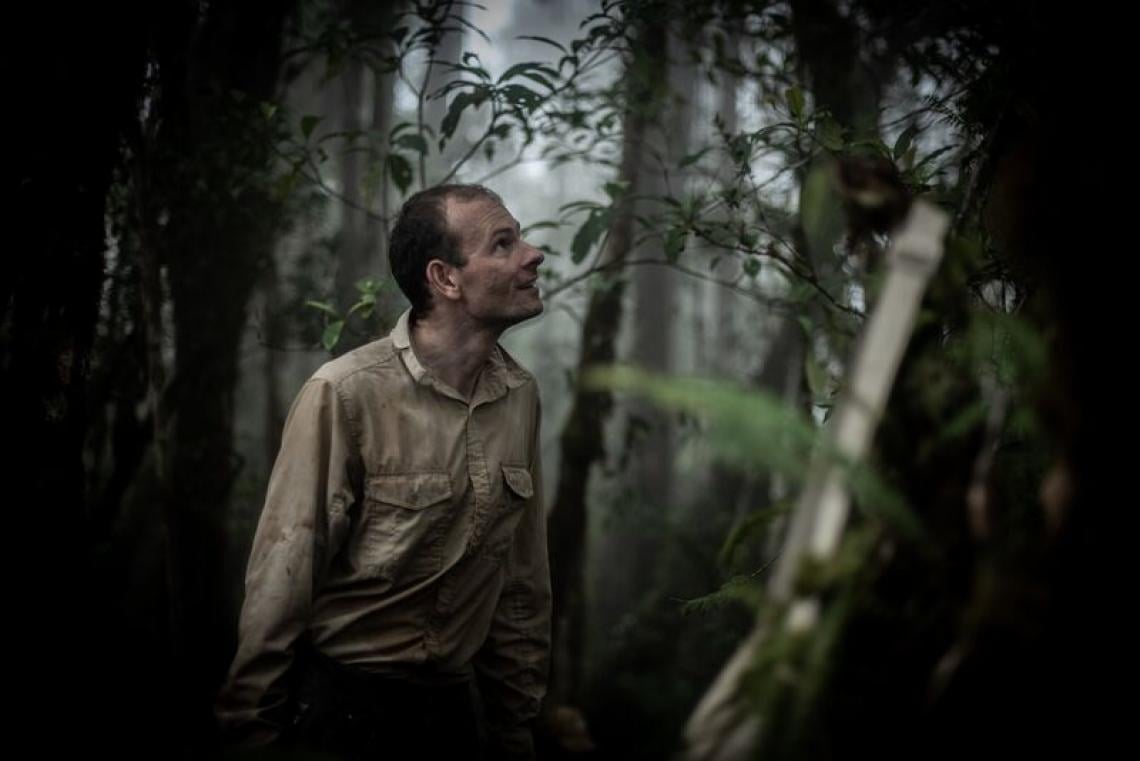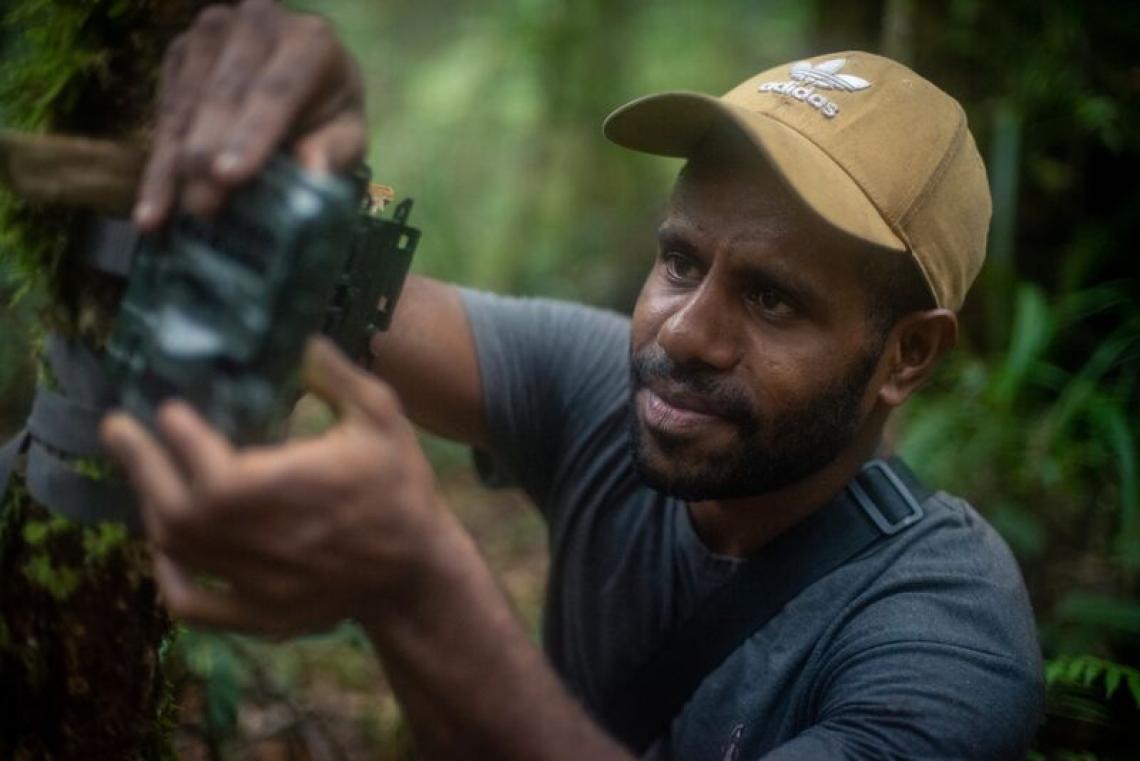Camera trap photo of Attenborough’s long-beaked echidna. This image and the two others that the team obtained through trail cameras were the final images on the final SD card the team collected on the final day of the final ascent of the Cyclops Mountains.
More than 60 years after the collection of the only scientific evidence of Attenborough’s long-beaked echidna (Zaglossus attenboroughi), a biodiversity training expedition team led by Indonesian NGO Yayasan Pelayanan Papua Nenda (YAPPENDA), with students from Cenderawasih University (UNCEN) and supported by researchers from Oxford University, has recently rediscovered the toddling, nocturnal, egg-laying mammal in Indonesia’s Cyclops Mountains in the Province of Papua.
Attenborough’s long-beaked echidna, named after famed broadcaster and natural historian Sir David Attenborough and known in the local Tepera language as ‘payangko,’ is one of Re:wild’s most wanted lost species. The expedition team—which also included biologists from Mendel University in Brno, Royal Holloway University in London, and Re:wild—captured the first-ever photos and video of the echidna on remote trail cameras set up in the tropical rainforests of the Indonesian province of Papua. The team will be submitting a manuscript on the rediscovery to bioRxiv, a biology preprint server, imminently.
“One of the goals of YAPPENDA is to ensure the preservation of the Cyclops Mountains and their remarkable biodiversity,” said Malcolm Kobak, cofounder of YAPPENDA. “To see photos of this endemic species is both encouraging and inspiring. The payangko holds a special place in the traditions of the Indigenous inhabitants of the Cyclops and is emblematic of Cyclops’ conservation efforts. We hope this story inspires renewed interest and motivates increased protection for this unique place.”
The expedition was supported by Papua BBKSDA, an arm of the Indonesian Ministry for Forestry and the Environment that administers the Cyclops Mountains Nature Reserve. Through a research collaboration with the University of Oxford, the Indonesian National Research and Innovation Agency (BRIN) also supported the expedition. The support of both Indonesian institutions ensured all necessary permits were granted.
Critical to the expedition’s success was the support of customary landowners within the Cyclops Mountains, which was generously given by members of Yongsu Sapari, a community on the range’s northern side. The community has lived on their land for 18 generations. In addition to granting permission to the expedition team to conduct part of the expedition on their land, members of the community of Yongsu Sapari also assisted expedition work.
The echidna has special cultural significance for the people of Yongsu Sapari. When there is a conflict within the community, rather than fighting, there is a tradition that one party goes up into the Cyclops to search for an echidna while the other party goes to the ocean to find a marlin. Both creatures were so difficult to find that it would often take decades or a whole generation to locate them, but, once found, the animals symbolized the end of the conflict and a return to harmonious relationships in the village.
The expedition, which was planned over three-and-a-half years, involved deploying 80 trail cameras. The team had to climb more than 36,000 feet (11,000 meters). The team spent four weeks in the forest without seeing the echidna. The three images they obtained were the last images on the final SD card they collected on the last day of the ascent of the Cyclops Mountains. The identification of the species was later confirmed by Professor Kristofer Helgen, mammalogist and chief scientist and director of the Australian Museum Research Institute (AMRI).
“Possessing the quills of a porcupine, the snout of an anteater, and the feet of a mole, the echidna is as much a chimera as its mythological namesake,” said James Kempton, postdoctoral researcher at the University of Oxford and leader of the expedition. “Like the duck-billed platypus, they are monotremes—egg-laying mammals that have evolved independently of other mammals for over 200 million years. Before this expedition, we knew of only four monotreme species certain to have survived to the modern day: sole survivors that protect a unique and fragile evolutionary history. Attenborough’s long-beaked echidna is another, crucial guardian of this ancient lineage, and finding it after years of preparatory toil and weeks of discomfort in the field, was a moment of pure catharsis.”
Although the species has been lost to science since 1961—the same year John F. Kennedy became president of the United States—the Yongsu Sapari community reported more recent sightings, while expedition team member Gison Morib discovered signs of the echidna during pre-expedition work in 2022. These signs, also observed during the expedition, include burrows and ‘nose pokes,’ holes in the ground left by echidnas after using their long, slightly curved snouts to probe for worms.
Dr. James Kempton, postdoctoral researcher at the University of Oxford and leader of the expedition.
Attenborough’s long-beaked echidna is classified as critically endangered on the IUCN Red List of Threatened Species, and is one of five surviving species of monotreme, the ancient clade of egg-laying mammals found only in Australia and New Guinea (which also includes the platypus). Echidnas are nocturnal, live in burrows and tend to be very shy, which also adds to the challenge of finding them. It is the smallest of the three long-beaked echidna species.
The echidna is also an EDGE species—a threatened species that has few close relatives on the evolutionary tree of life. Attenborough’s long-beaked echidna is not known to live anywhere else and biologists still have many unanswered questions about its habitat and ecology.
In addition to Attenborough’s long-beaked echidna, the team also obtained the first media documentation since 2008 of Mayr’s honeyeater (Ptiloprora mayri), a bird named after famed evolutionary biologist Ernst Mayr.
“The fact that Mayr’s honeyeater was one of only 130 bird species in the world with no confirmed documentation in the last 10 or more years demonstrates how rarely scientists and birdwatchers visit the Cyclops range and emphasizes how much remains to be discovered about the birds and other biodiversity of these unique mountains,” said John Mittermeier, director of the lost birds program at American Bird Conservancy. “It is hugely exciting that the research team and their local collaborators were able to find and photograph the honeyeater and, best of all, that their findings confirm that the forest home of the species remains in good condition.”
Gison Morib, with Cenderawasih University (UNCEN), setting up camera traps in search of Attenborough’s long-beaked echidna
Allbirds supports the Search for Lost Birds, which is a partnership between American Bird Conservancy, Re:wild, and BirdLife International, in addition to Re:wild’s broader Search for Lost Species.
An important reason that the echidna and bird have been lost to science is because the Cyclops Mountains are rugged, steep, dangerous, and possess abundant populations of malarial mosquitoes, venomous snakes and are teeming with leeches (one member of the team had a leech stuck behind his eye for a number of days, another broke two fingers, and another contracted malaria). The Cyclops Mountains range from sea level to 6,170 feet (1,880 meters), and the team searched for the echidna across these elevations. This physically inhospitable environment has protected this habitat, while simultaneously preventing exploration and scientific study.
Not only are the Cyclops Mountains a Key Biodiversity Area, which means that they are critical to the persistence of biodiversity and to the overall health of the planet, they are also an important watershed for nearby towns and the nearby population centers of Sentani and Jayapura.
“You’d be hard pressed to find a cooler, weirder, more wonderful lost—now found—species,” said Andrew Tilker, Re:wild species conservation coordinator and member of the expedition team. “The fact that there is this small mammal with a snout that lays eggs and sort of stumbles around through these tropical forests blows my mind, even though we work on the conservation of all kinds of unique species. It’s also the perfect flagship species for the Cyclops Mountains, representing how special and irreplaceable Indonesia’s natural heritage is.”
The next steps for the expedition team include the long-term monitoring of the echidna and strengthening engagement with local communities to enhance their conservation efforts. YAPPENDA will continue its work with Papua BBKSDA, Indigenous landowners and other stakeholders to ensure the continued and enhanced protection of the species and the Cyclops Mountains in which it lives.
This rediscovery was made possible in part by the generous support of Merton College Oxford, the Royal Geographical Society, the Scientific Exploration Society, Re:wild, Royal Holloway University, the University of Oxford, and private donations from Derek Williams, Chris Peri, and other generous individuals. Reconyx kindly donated half of the deployed camera traps for free.
Since the Search for Lost Species program launched in 2017, working with partners across the globe and with support from Colossal Biosciences, Re:wild has confirmed the rediscovery of these nine additional species on the list of the world’s most wanted lost species: Jackson’s climbing salamander in Guatemala, both the Wallace’s giant bee and the velvet pitcher plant in Indonesia, the silver-backed chevrotain in Vietnam, the Somali sengi in Djibouti, the Voeltzkow’s chameleon in Madagascar, the Fernandina giant tortoise in the Galápagos, the Sierra Leone crab in Sierra Leone and the Pernambuco holly tree in Brazil.
Additional quotes
Leonidas-Romanos Davranoglou, a Leverhulme Trust Postdoctoral Fellow, entomologist at the Oxford University Museum of Natural History and expedition team member
"We believe that our rediscovery of Attenborough's long-beaked echidna will allow it to serve as a flagship species and a beacon of hope for the preservation of Mount Cyclops' entire forest ecosystem. Our team's discoveries, including numerous previously unknown arthropod species, underscore the significance of this extraordinary habitat."
Amir Hamidy, Secretariat of the Scientific Authority for Biodiversity at BRIN
“Under Indonesian law only two monotremes are listed as protected species: the short-beaked echidna and the western long-beaked echidna. However, alongside the eastern long-beaked echidna, the rediscovered Attenborough’s long-beaked echidna is not protected, and it is important that follow-up work is undertaken to evaluate the conservation status of these monotremes and ensure they are appropriately protected.”
Professor Kristofer Helgen, mammalogist and chief scientist and director of the Australian Museum Research Institute (AMRI)
“Egg-laying mammals, or monotremes, are very special beasts, the first offshoot on the family tree of all living mammals. As a global community we need to do everything we can to protect the survival of all remaining monotremes. The scientific rediscovery of this particularly unique echidna is astonishingly good news, and the starting point for ensuring its long-term conservation. Echidnas are indeed my favorite mammals of all, so I am especially thrilled.”
Ben Lamm, founder and CEO of Colossal
“Attenborough’s long-beaked echidna has long been a favorite species of ours that we insistently debated with researchers and museum curators was still extant, its rediscovery reinforces Colossal’s commitment to support the Search for Lost Species and de-extinction through all channels possible.”
Gison Morib, Cenderawasih University student and expedition team member
“This expedition provided education for six UNCEN biology students, who were directly involved in the field. We gained a lot of knowledge in terms of diversity survey techniques, including herpetology techniques, entomology, camera traps, and the correct use of GPS. Not only did we gain knowledge, but also imparted ecological knowledge to the local residents who took part directly in this expedition."
Pascal Marcel Norotouw, Numbay Research Center (NRC) and expedition team member
“We are beyond grateful for the opportunity to be a part of history and to be part of the group of young scientists who we shared and exchanged knowledge throughout the expedition. We hope that the success of this expedition will possibly pave the way for future research that will be of benefit to our people along Cyclops.”
Suriani Suryanti, Mammalogist at Cenderawasih University
“Monotremes are unique among mammals in possessing cloaca, lacking nipples, and laying eggs.”
# # #
Re:wild
Re:wild protects and restores the wild. We have a singular and powerful focus: the wild as the most effective solution to the interconnected climate, biodiversity and human wellbeing crises. Founded by a group of renowned conservation scientists together with Leonardo DiCaprio, Re:wild is a force multiplier that brings together Indigenous peoples, local communities, influential leaders, nongovernmental organizations, governments, companies and the public to protect and rewild at the scale and speed we need. Learn more at rewild.org.
University of Oxford
Oxford University has been placed number 1 in the Times Higher Education World University Rankings for the seventh year running, and number 2 in the QS World Rankings 2022. At the heart of this success are the twin-pillars of our ground-breaking research and innovation and our distinctive educational offer. Oxford is world-famous for research and teaching excellence and home to some of the most talented people from across the globe. Our work helps the lives of millions, solving real-world problems through a huge network of partnerships and collaborations. The breadth and interdisciplinary nature of our research alongside our personalised approach to teaching sparks imaginative and inventive insights and solutions.
YAPPENDA (Yayasan Pelayanan Papua Nenda)
We are a Papuan Indonesian NGO with a vision to ensure a thriving Papua, where indigenous Papuans are empowered into protecting and restoring their natural environment for the benefit of their culture and livelihood. Our mission is to protect, advocate for, sustain and restore the natural environment through empowerment of indigenous Papuans. Our principals are guided by Indigenous values and knowledge, deep and sustained local consultation, and inclusivity of gender, tribal groups, culture and religion. Our current programs include reforestation and restoration, livelihood development, education, protected area establishment and indigenous co-management, wildlife crime prevention, exploration, research and monitoring. For more information http://www.yappenda.org
Contact
Lindsay Renick Mayer
Re:wild
[email protected]
Devin Murphy
Re:wild
[email protected]






